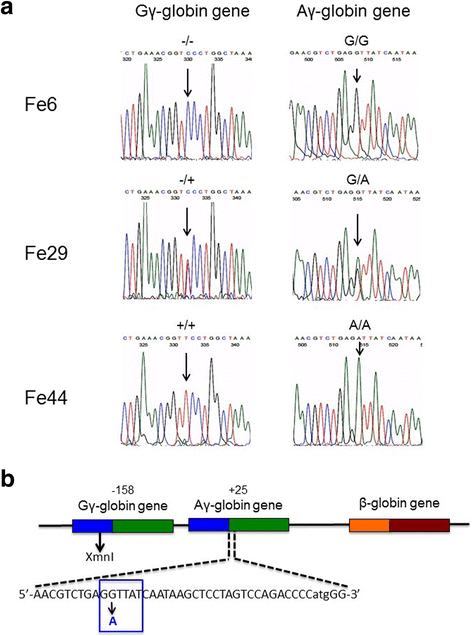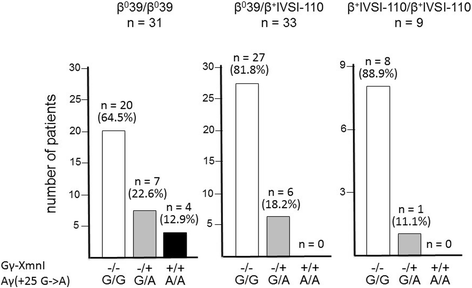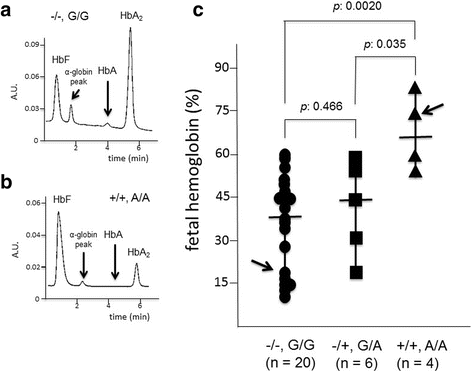An Aγ-globin G->A gene polymorphism associated with β039 thalassemia globin gene and high fetal hemoglobin production
- PMID: 28851297
- PMCID: PMC5575872
- DOI: 10.1186/s12881-017-0450-3
An Aγ-globin G->A gene polymorphism associated with β039 thalassemia globin gene and high fetal hemoglobin production
Abstract
Background: Increase of the expression of γ-globin gene and high production of fetal hemoglobin (HbF) in β-thalassemia patients is widely accepted as associated with a milder or even asymptomatic disease. The search for HbF-associated polymorphisms (such as the XmnI, BCL11A and MYB polymorphisms) has recently gained great attention, in order to stratify β-thalassemia patients with respect to expectancy of the first transfusion, need for annual intake of blood, response to HbF inducers (the most studied of which is hydroxyurea).
Methods: Aγ-globin gene sequencing was performed on genomic DNA isolated from a total of 75 β-thalassemia patients, including 31 β039/β039, 33 β039/β+IVSI-110, 9 β+IVSI-110/β+IVSI-110, one β0IVSI-1/β+IVSI-6 and one β039/β+IVSI-6.
Results: The results show that the rs368698783 polymorphism is present in β-thalassemia patients in the 5'UTR sequence (+25) of the Aγ-globin gene, known to affect the LYAR (human homologue of mouse Ly-1 antibody reactive clone) binding site 5'-GGTTAT-3'. This Aγ(+25 G->A) polymorphism is associated with the Gγ-globin-XmnI polymorphism and both are linked with the β039-globin gene, but not with the β+IVSI-110-globin gene. In agreement with the expectation that this mutation alters the LYAR binding activity, we found that the Aγ(+25 G->A) and Gγ-globin-XmnI polymorphisms are associated with high HbF in erythroid precursor cells isolated from β039/β039 thalassemia patients.
Conclusions: As a potential explanation of our findings, we hypothesize that in β-thalassemia the Gγ-globin-XmnI/Aγ-globin-(G->A) genotype is frequently under genetic linkage with β0-thalassemia mutations, but not with the β+-thalassemia mutation here studied (i.e. β+IVSI-110) and that this genetic combination has been selected within the population of β0-thalassemia patients, due to functional association with high HbF. Here we describe the characterization of the rs368698783 (+25 G->A) polymorphism of the Aγ-globin gene associated in β039 thalassemia patients with high HbF in erythroid precursor cells.
Keywords: Aγ-globin gene polymorphism; Fetal hemoglobin; LYAR; β-thalassemia.
Conflict of interest statement
Ethics approval and consent to participate
The collection and processing of the human biological samples for this research were carried out by the Ethics Committee of Ferrara District, number 06/2013 (approved on June 20, 2013), and by CESC (Ethics Committee of Rovigo and Verona Districts), number 36056 (approved on August 5, 2014). The study complies with the Declaration of Helsinki, the principles of Good Clinical Practice and all further applicable regulations. All samples of peripheral blood have been obtained after written documentation of informed consent from patient or legal representative. Copies of the consents have been collected for archiving by the “Day Hospital Talassemici”, Divisione Pediatrica of Hospital S. Anna, Ferrara, Italy and by the Department of Transfusional Medicine - ULSS 18, Rovigo, Italy.
Consent for publication
All the subjects involved in the present study gave their consent to publish the data obtained.
Competing interests
The authors declare that they have no competing interest.
Publisher’s Note
Springer Nature remains neutral with regard to jurisdictional claims in published maps and institutional affiliations.
Figures




Similar articles
-
Structural and Functional Insights on an Uncharacterized Aγ-Globin-Gene Polymorphism Present in Four β0-Thalassemia Families with High Fetal Hemoglobin Levels.Mol Diagn Ther. 2016 Apr;20(2):161-73. doi: 10.1007/s40291-016-0187-2. Mol Diagn Ther. 2016. PMID: 26897028
-
The rs368698783 (G>A) Polymorphism Affecting LYAR Binding to the Aγ-Globin Gene Is Associated with High Fetal Hemoglobin (HbF) in β-Thalassemia Erythroid Precursor Cells Treated with HbF Inducers.Int J Mol Sci. 2023 Jan 1;24(1):776. doi: 10.3390/ijms24010776. Int J Mol Sci. 2023. PMID: 36614221 Free PMC article.
-
Surface plasmon resonance based analysis of the binding of LYAR protein to the rs368698783 (G>A) polymorphic Aγ-globin gene sequences mutated in β-thalassemia.Anal Bioanal Chem. 2019 Nov;411(29):7699-7707. doi: 10.1007/s00216-019-01987-9. Epub 2019 Jul 12. Anal Bioanal Chem. 2019. PMID: 31300855
-
Interpreting elevated fetal hemoglobin in pathology and health at the basic laboratory level: new and known γ- gene mutations associated with hereditary persistence of fetal hemoglobin.Int J Lab Hematol. 2014 Feb;36(1):13-9. doi: 10.1111/ijlh.12094. Epub 2013 Apr 29. Int J Lab Hematol. 2014. PMID: 23621512 Review.
-
Fetal globin induction in beta-thalassemia.Hemoglobin. 2009;33 Suppl 1:S197-203. doi: 10.3109/03630260903351882. Hemoglobin. 2009. PMID: 20001626 Review.
Cited by
-
Treatment of Erythroid Precursor Cells from β-Thalassemia Patients with Cinchona Alkaloids: Induction of Fetal Hemoglobin Production.Int J Mol Sci. 2021 Dec 14;22(24):13433. doi: 10.3390/ijms222413433. Int J Mol Sci. 2021. PMID: 34948226 Free PMC article.
-
[Rare thalassemia caused by novel nucleotide variants in the globin gene: four case reports and literature review].Zhonghua Xue Ye Xue Za Zhi. 2021 Apr 14;42(4):313-317. doi: 10.3760/cma.j.issn.0253-2727.2021.04.008. Zhonghua Xue Ye Xue Za Zhi. 2021. PMID: 33979976 Free PMC article. Review. Chinese.
-
The Long Scientific Journey of Sirolimus (Rapamycin): From the Soil of Easter Island (Rapa Nui) to Applied Research and Clinical Trials on β-Thalassemia and Other Hemoglobinopathies.Biology (Basel). 2023 Sep 2;12(9):1202. doi: 10.3390/biology12091202. Biology (Basel). 2023. PMID: 37759601 Free PMC article. Review.
-
MicroRNAs and Long Non-coding RNAs in Genetic Diseases.Mol Diagn Ther. 2019 Apr;23(2):155-171. doi: 10.1007/s40291-018-0380-6. Mol Diagn Ther. 2019. PMID: 30610665 Free PMC article. Review.
-
High level of fetal-globin reactivation by designed transcriptional activator-like effector.Blood Adv. 2020 Feb 25;4(4):687-695. doi: 10.1182/bloodadvances.2019000482. Blood Adv. 2020. PMID: 32084259 Free PMC article.
References
Publication types
MeSH terms
Substances
LinkOut - more resources
Full Text Sources
Other Literature Sources
Molecular Biology Databases
Research Materials

